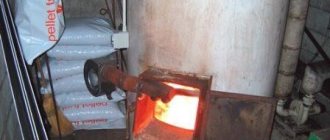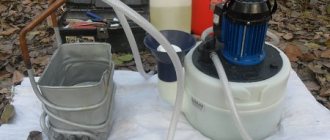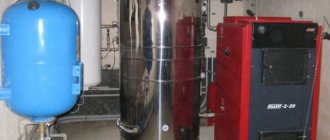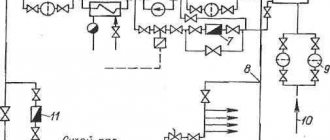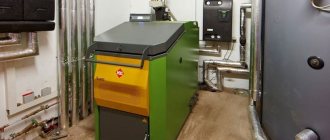Home / Commissioning
Back
Published: 06/01/2019
Reading time: 3 min
0
2630
Before choosing and purchasing, it is worth making a correct calculation of the efficiency of the boiler and clarifying all its parameters and factors that will affect its operation and the amount of heat generated.
- 1 What is boiler efficiency and what processes affect its value
- 2 How to calculate efficiency
- 3 How to increase the efficiency of a gas boiler
- 4 Gas boilers with the highest efficiency
How to choose a boiler
Of course, in order to determine how efficient a particular hot water boiler will be, it is necessary to determine its efficiency (efficiency factor). This indicator represents the ratio of the heat used to heat the room to the total amount of thermal energy generated.
The formula for calculating efficiency looks like this:
ɳ=(Q1÷Qri),
where Q1 is heat used efficiently;
Qri is the total amount of heat generated.
Basic criteria for choosing a boiler
In addition to the fuel consumption characteristics, there are a number of criteria that affect the economic parameters of the boiler. This applies to service life, device efficiency, materials, etc.
Material
The efficiency parameter of gas heating boilers is directly dependent on their service life. Gas units with a heat exchanger made of cast iron are considered to have the longest service life and reliability. These boilers are designed to last up to 50 years. But, the disadvantage of this material is its fragility, therefore, you need to be very careful when moving it. Only with careful and careful operation can a long service life be achieved. In addition to the required caution, it is also important to avoid temperature changes, for example, cold water should not come into contact with the surface of a heated heat exchanger, as this can lead to the formation of cracks.
Floor-standing units in which the contours are made of steel are not as capricious as those made of cast iron. But, at the same time, they are more susceptible to corrosion, therefore, their service life is shorter.
Availability of components
An important parameter affecting the service life is the commercial availability of spare parts, as well as their quality. When purchasing a unit, it is recommended to find out how easy it is to find the necessary components. Therefore, it is logical that it is easier to select the necessary parts for more well-known and popular brands.
Manufacturers
As for the country of origin, the most durable devices are considered to be those made in German, Italian and Slovakia. Similar equipment produced by domestic companies often has a shorter service life, although they are better suited to operating conditions in Russia and, in addition, they are lower in cost.
Scheduled checks
There are users of gas boilers who, to save money, do not contact service, or do not regularly carry out scheduled checks. However, this is a big mistake, since during operation of the boiler various situations can occur, for example, the burner focus shifts. This will lead to carbon deposits, and then minor malfunctions may occur. If they are not noticed and corrected in due time, this can lead to an increase in gas consumption and a decrease in boiler performance. This is a good example that you shouldn’t skimp on routine checks.
Unit efficiency
An important indicator that you need to focus on when selecting economical gas boilers for a private home is the efficiency factor.
For example, for floor-standing gas devices, efficiency = 85-90%. Lower performance is characteristic of cheaper units that are equipped with a single-stage or two-stage burner.
Boilers with smoothly varying power are considered more efficient. The heat generated during fuel combustion begins to heat the heat exchanger with the coolant. The residual heat then enters the atmosphere through the chimney.
The amount of heat that is lost can be calculated by measuring the flue gas temperature. A device in which the smoke is heated to 100-150°C is considered economical. If the temperature is more than 200°C, then the device does not have high economic performance.
A gas unit for housing with the highest economic parameters is considered a condensing boiler, which has a special technology for extracting heat from the formed condensate. Condensing boilers have an efficiency of more than 100%.
Taking into account various criteria that directly influence the economic performance of gas units, we can identify a number of models that have the necessary economic quality.
What is the relationship between boiler efficiency and load
At first glance it may seem that the more fuel is burned, the better the boiler works. However, this is not quite true. The dependence of the boiler efficiency on the load is just the opposite. The more fuel is burned, the more thermal energy is released. At the same time, the level of heat loss also increases, since highly heated flue gases go into the chimney. Consequently, fuel is consumed inefficiently.
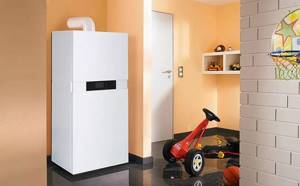
The situation develops in a similar way in cases where the heating boiler operates at reduced power. If it falls short of the recommended values by more than 15%, the fuel will not burn completely and the amount of flue gases will increase. As a result, the efficiency of the boiler will drop quite significantly. This is why you should adhere to the recommended boiler power levels - they are designed to operate the equipment as efficiently as possible.
Installing radiators for maximum efficiency
Radiators are installed in areas where heat loss in the room is most significant, for example, next to windows. To achieve maximum efficiency, the window sill should cover about 2/3 of the upper plane of the battery and be approximately 10 cm from its surface. The recommended distance between the radiator and the floor is 12 cm. The rear surface of the battery should be separated from the wall by 2 cm. This will create proper natural convection , in which a certain amount of heat is spent on heating the wall and blocking heat loss in the room, and most of the energy is directed to heating.
Safety measures for increasing efficiency
Just 20-30 years ago, the price of energy resources in the post-Soviet space was low, so no one paid attention to such a parameter as efficiency. After all, performance could decide everything. But when gas began to rise in price, and modern technologies were still unavailable, craftsmen began to modernize gas boilers in order to increase efficiency, using accessible methods.
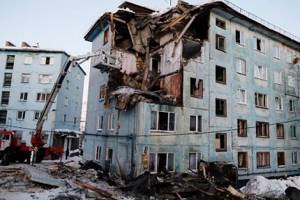
When performing any work with gas equipment, it is necessary to observe safety measures and possess special skills and tools. And also you should not use methods prohibited by law to increase efficiency.
For example, attaching copper and aluminum plates to heat exchangers to improve heat transfer. Heat loss from structural elements of heating devices was reduced by welding third-party elements. The automation and heat exchangers were changed. Other similar methods were also used. Efficiency increased, but the state and the gas service did not react to the “creativity” of the craftsmen.
Now everything is different and relevant laws prohibit changing the design of gas boilers, which must be certified, like all their individual elements. As a result, it is impossible to increase efficiency by replacing mechanical, electrical and other components of heating devices with third-party ones.
Violation of these requirements may result in:
- Administrative responsibility. If Gorgaz employees detect tampering with the boiler design, but there were no incidents, they will have to pay a fine of 10-15 thousand rubles. This is indicated by Article 7.19 of the Administrative Code. In severe cases, the gas service has the right to even terminate the service contract and stop supplying fuel.
- Criminal liability. As evidenced by Federal Law No. 229-FZ of July 29, 2018 “On amendments to Article 215.3 of the Criminal Code of the Russian Federation and Articles 150 and 151 of the Code of Criminal Procedure of the Russian Federation.” These standards will come into force if design changes lead to serious consequences.
That is, it’s not worth risking people’s lives to increase the efficiency of the boiler by a few percent.
Calculation of efficiency taking into account various factors
The above formula is not entirely suitable for assessing the efficiency of equipment, since it is very difficult to accurately calculate the boiler efficiency taking into account only two indicators. In practice, a different, more complete formula is used during the design process, since not all of the heat generated is used to heat the water in the heating circuit. A certain amount of heat is lost during the operation of the boiler.
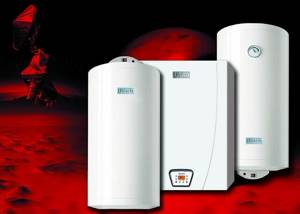
A more accurate calculation of boiler efficiency is made using the following formula:
ɳ=100-(q2+q3+q4+q5+q6), in which
q2 – heat loss from escaping flammable gases;
q3 – heat loss as a result of incomplete combustion of combustion products;
q4 – heat loss due to underburning of fuel and ash precipitation;
q5 – losses caused by external cooling of the device;
q6 – heat loss along with slag removed from the furnace.
Values of modern boilers depending on the type of fuel
| Photo | Type of boiler depending on the fuel burned | Average efficiency, % |
| Gas | ||
| — Convection | 87-94 | |
| — Condensation | 104-116* | |
| Solid fuel | ||
| — Wood-burning | 75-87 | |
| — Coal | 80-88 | |
| — Pellet | 80-92 | |
| Liquid fuel | ||
| — On diesel fuel | 86-91 | |
| — On fuel oil | 85-88 | |
| Electric heating elements | 99-99,5 |
*From a physics point of view, efficiency cannot exceed 100%: it is impossible to obtain more thermal energy than is released when burning fuel. However, it all depends on how you count. There are two definitions:
- lower calorific value - the heat obtained during the combustion of fuel, when the combustion products are simply removed through the chimney;
- higher calorific value - heat, including the energy contained in water vapor - one of the products of combustion of flammable gases.
Gas condensing boilers additionally accumulate the thermal energy of condensate formed from gas combustion products and deposited on an additional heat exchanger. Thus, a significant part of the heat does not “fly out into the chimney”, and the temperature of the exhaust gases is almost equal to atmospheric.
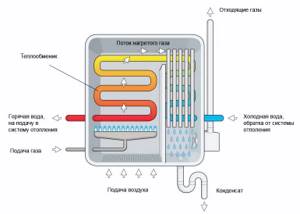
Construction of a simple condensing single-circuit gas boiler.
According to current standards, both in Russia and in Europe, the efficiency of heating boilers is calculated based on the lowest specific calorific value, so taking into account the additional heat extracted from the condensate leads to values of more than 100%. When calculated based on the higher calorific value, the efficiency of condensing gas boilers is 96-98%, depending on the model and type of installation: wall-mounted boilers usually have higher efficiency than floor-standing boilers (this applies to all gas boilers).
Also from the table you can see that the average efficiency of solid fuel boilers also differs depending on the fuel used, this is due to the degree of fuel combustion, its heat transfer, combustion temperature and heat loss with physical heat of slag removed from the combustion chamber. Even the same solid fuel boiler can produce different efficiencies when operating on different types of fuel.
Heat loss when removing flammable gases
The most significant heat losses occur as a result of the evacuation of flammable gases into the chimney (q2). The efficiency of the boiler largely depends on the combustion temperature of the fuel. The optimal temperature pressure at the cold end of the water heater is achieved when heated to 70-110 ℃.
When the temperature of the exhaust combustible gases drops by 12-15 ℃, the efficiency of the water heating boiler increases by 1%. However, in order to reduce the temperature of the exhaust combustion products, it is necessary to increase the size of the heated surfaces, and, therefore, the entire structure as a whole. In addition, as carbon monoxide cools, the risk of low-temperature corrosion increases.
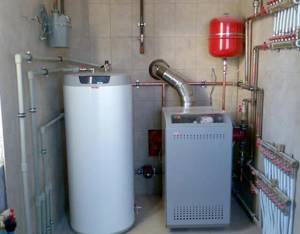
Among other things, the temperature of carbon monoxide also depends on the quality and type of fuel, as well as the heating of the air entering the firebox. The temperatures of incoming air and exiting combustion products depend on the type of fuel.
To calculate the heat loss rate with flue gases, use the following formula:
Q2= (T1-T3) × (A2 ÷ (21-O2) + B), where
T1 – temperature of evacuated flammable gases at a point downstream of the superheater;
T3 – temperature of air entering the furnace;
21 – oxygen concentration in the air;
O2 is the amount of oxygen in the exhaust combustion products at the control point;
A2 and B are coefficients from a special table that depend on the type of fuel.
What to do with the chimney
The performance of boilers is greatly influenced by the condition of the combustion products discharge pipe. If the chimney becomes clogged with soot, this will reduce its diameter and, accordingly, draft. Experts recommend checking the condition of the pipe that discharges gas combustion products at least once a year.

To increase efficiency, it is best to connect a closed-type boiler to a coaxial chimney. In this case, the air will begin to enter the combustion chamber through the outer cavity of the two-cavity pipe, already slightly heated. This, in turn, will reduce the initial heat costs by several percent.
Chemical underburning as a source of heat loss
The q3 indicator is used when calculating the efficiency of a gas heating boiler, for example, or in cases where fuel oil is used as fuel. For gas boilers, the q3 value is 0.1-0.2%. With a slight excess of air during combustion, this figure is 0.15%, and with a significant excess of air it is not taken into account at all. However, when burning a mixture of gases of different temperatures, the value of q3 = 0.4-0.5%.

If the heating equipment runs on solid fuel, the q4 indicator is taken into account. In particular, for anthracite coal the value of q4 = 4-6%, semi-anthracite is characterized by 3-4% heat loss, but when burning hard coal, only 1.5-2% heat loss is formed. For liquid slag removal of burned low-reaction coal, the value of q4 can be considered minimal. But when removing slag in solid form, heat loss will increase to the maximum limit.
What should an energy efficient boiler be like?
The characteristics specified in the documents and rich practical experience show that imported boilers have the highest efficiency. European manufacturers pay special attention to the use of energy-saving technologies, which allows them to get the most out of their equipment. Let’s make a “portrait” of an ideal gas boiler:
- modulation burner - automatically adapts to the operating mode of the system, minimizing the percentage of underburning;
- heating the coolant no more than 70 degrees, exhaust gases - up to 110 degrees, which ensures an optimal balance of efficiency, it is desirable to have a condensation heat exchanger;
- coaxial chimney - a closed combustion chamber requires the equipment to have a pipe-in-pipe channel for removing combustion products, which allows heating the air flow from the street;
- recirculation system - allows you to use the heat of exhaust gases to heat the room.
Of course, such an ideal boiler does not exist, but a list of the best technical solutions will help you choose a worthy model.
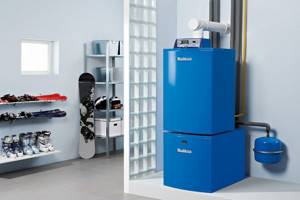
What determines the thermal efficiency of boiler units?

The operating principle of a classic floor-mounted gas atmosphere.
The efficiency of heating boilers is not equal at any power; there is a proportional dependence on the load: an increase in the thermal load (the amount of fuel burned) also increases heat loss through the body or chimney. Likewise, operation at minimum power does not always ensure complete combustion of fuel, which leads to a decrease in efficiency.
For example, the service instructions for gas boilers Protherm Wolf KSO with a power of 12.5 kW and 16.0 kW indicate that when operating at maximum power (12.8 kW and 16.3 kW, respectively), the efficiency is 92.5%, while time when operating with a minimum load (4.5 kW and 5.8 kW) - will decrease and amount to only 78.4%.
This is one of the main reasons why you should take a conscious approach to choosing the power of the boiler unit. The most optimal operation in most models is achieved at a load in the range of 60-90% of maximum power.
Otherwise, the efficiency depends solely on the technological excellence of the model, aimed at reducing the above-described q2-6 (reducing the temperature of exhaust gases, efficient combustion of fuel, modulating burners, thermal insulation, etc.), as well as on the quality of maintenance and operation of the boiler unit. Cleanliness of the coolant, regular cleaning and flushing - all this over time seriously affects the efficiency.
Ventilation of premises
Special attention should be paid to checking ventilation - it determines how well air flows into the boiler and how much less carbon monoxide is left for residents. The quality of gas combustion depends on the first (which directly affects the efficiency), and the health of the boiler owners depends on the second.
This is true for boilers with “internal” draft, when air is supplied to the firebox directly from the room in which the boiler is installed.
In the second case, when combustion air is taken from the street, regular cleaning of the duct and dampers is necessary, because the efficiency of heating boilers is affected by the lack and excess of incoming oxygen. And if the air duct is completely clogged, then nothing good will come of it.
Ways to increase efficiency
In order for the heating system to operate with minimal heat loss, you should familiarize yourself with effective ways to improve the efficiency of a gas boiler
. To do this, it is necessary to eliminate as much as possible all types of heat loss.
- To reduce the percentage of physical underburning, you should monitor the condition and cleanliness of the flame tubes and water circuit. Soot forms on the pipeline, and scale forms on the circuit, so these elements of the heating system require regular cleaning.
- There should be no excess air in a gas boiler, since heat that could be used to heat the coolant also goes into the chimney with it.
This problem can be solved by installing a draft limiter on the chimney pipe. How gases circulate in the boiler - Adjusting the blower damper. This can be done using a thermometer installed in the boiler. You just need to put the damper in such a position that the maximum coolant temperature is achieved.
- Make sure that normal traction is maintained. It decreases as a result of the narrowing of the chimney cross-section. This can be avoided if you regularly clean the outlet pipe, because soot sticks to its walls.
- It is necessary to regularly clean the combustion chamber, as soot forms on the surface of its walls, which increases fuel consumption.
Installation of a coaxial chimney
If you are looking for options on how to increase the efficiency of a gas boiler, pay attention to what kind of chimney is installed. Traditional outlet pipes have a number of disadvantages, the main one of which is dependence on weather conditions
An alternative to a conventional chimney can be a coaxial chimney, which has the following advantages:
- significantly increases the efficiency of a gas boiler;
- resistant to high temperatures;
- can be made in different versions;
- allows you to save fuel;
- ensures long-term maintenance of room temperature.
Coaxial chimney
The installation of a coaxial chimney does not require much effort. The design consists of two exhaust pipes of different diameters, one transports exhaust gases, and the other carries oxygen-saturated air.
If you have no experience working with heating equipment, but there is a need to resolve the issue of how to improve the efficiency of a gas boiler, contact a specialist. They will perform the work at the highest level, ensuring the most efficient functioning of your home's heating system.
Choosing a boiler for autonomous heat supply
Classification of heating boilers
When starting to complete an autonomous heat supply, special attention should be paid to the boiler. This device is key in organizing the entire system
Since it is impossible to select a gas heating boiler without basic knowledge of its properties, you need to at least superficially study its characteristics.
They reflect not only its functionality, but also its performance qualities. In addition, each type of boiler has its own requirements for installation and further technology for preventing breakdowns.
Type of fuel used in the heating boiler
Design of an electric heating boiler
One of the determining parameters is the type of energy carrier. The easiest way is to choose an electric boiler for heating your home - to do this, you just need to connect the device correctly and make its correct wiring.
Currently, there are 4 main types of energy carriers that influence the correct selection of a boiler for heating a home:
- Gas. The most common, as it has an affordable cost and a large amount of thermal energy during combustion. In heating systems, main gas or liquefied (cylinder) gas can be used. However, before selecting a gas heating boiler, you need to decide on the company to install it. Doing this yourself without permission is prohibited;
- Solid and liquid fuels - firewood, coal, diesel. Choosing the right boiler for heating a house of this type is only possible if cheap energy resources are available. Also, the choice is forced if there is no gas main;
- Electricity. These are one of the most optimal types of energy for organizing heat supply to a small house or apartment. To select an electric heating boiler, its normal power is important. The general house network must be designed for such high loads.
Until recently, it was difficult to choose an effective electric boiler for heating. This was due to a relatively low efficiency rate. However, the emergence of new heating elements (heating elements) for water and the use of fundamentally different methods of increasing the temperature of the coolant using electricity have once again made boilers of this type in demand.
Operating features of the heating boiler
Design of a gas double-circuit boiler
The defining characteristics of a heating boiler include its rated power. It determines the maximum degree of heating of water in the pipes and, as a result, compliance with the thermal operating conditions of the entire heating supply. This parameter is calculated before choosing an electric heating boiler or its solid fuel (gas) analogue.
Modern boiler models are designed not only for heating, but also for hot water supply. For this purpose, their design provides a secondary heat exchange circuit, in which water is heated, which is then used for domestic purposes.
In addition, when choosing an electric heating boiler, you need to pay attention to the following points:
- Equipment. Some models may include a circulation pump, expansion tank and safety group;
- Operation control system. For solid fuel boilers, it is the simplest - a decrease or increase in the intensity of fuel combustion occurs by limiting the flow of fresh air. In electric or gas models, this function is performed by electronic devices;
- Installation method: wall or floor. The first option is acceptable if you are choosing an electric boiler for installation in the kitchen. It will take up little space and fit harmoniously into the overall interior of the room.
These are just general recommendations for choosing a heating boiler. The subtleties and nuances of its required technical (operational) characteristics depend on the design parameters of the heat supply system.
How to take into account the height of ceilings when calculating?
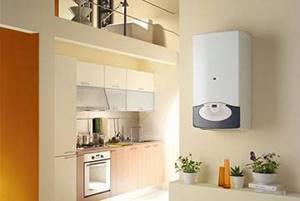
Those. do not exceed 2.6 - 3 meters. If the ceilings are higher, calculation by area will not work.
You need to use volume.
Knowing the volume of the room, you can calculate the predicted heat loss (HL) using the formula:
PT = V (volume) x Pt (difference t) x k: 860.
Pt – difference in average temperatures outside and indoors. Example: in winter the average temperature is -30 C, but in the house you want it to be 22 C. Pt = 52. The higher this indicator is, the more the building will lose heat.
k is the dispersion coefficient. It depends on the building materials from which the structure is made:
- Wood or corrugated iron, no insulation = 3–4.
- Single brickwork, regular windows and roof, average thermal insulation = 2 – 2.9.
- Double brickwork, good thermal insulation, few windows = 1 – 1.9.
- Excellent thermal insulation, plastic windows, well insulated floor and ceiling = 0.6 - 0.9.
Now that all the basic data is known, you can calculate the boiler power using the formula:
M = PT x kz.
Kz in these calculations is the safety factor. It is equal to 1.15 - 1.2 (that is, 15 - 20%)
Example. Brick house with good thermal insulation, area 60 m2. And the ceiling height is 3m.
- Let's calculate the volume. 60m2 x 3 = 180m3. Pt = 52, k = 1.5.
- We substitute the data into the formula: PT = 180 x 52 x 1.5: 860. PT = 16.32.
- We multiply this indicator by the safety factor: 16.32 x 1.2 = 19.58.
- We round up and get a boiler with a capacity of 20 kW.
Cast iron and steel structures - what are the differences?
Whatever material the boiler is made of, it is very important that it meets the basic operational characteristics. Let's look at them in more detail.
First of all, you should pay attention to the material of the heat exchanger - cast iron or steel. If you want to use a ready-made solid fuel boiler design, it’s unlikely that you’ll be able to make a cast iron heat exchanger yourself. Such work requires both special equipment and special knowledge and skills. Therefore, you can purchase ready-made sectional structures, which are disassembled before transportation and reassembled on site.
Cast iron heat exchangers tend to become covered with dry rust - a special film that protects the walls of the unit from destruction. In addition, wet rust also forms much more slowly, which is due to the long service life of cast iron products - from 10 to 25 years. Other advantages of cast iron heat exchangers include the absence of the need for frequent and complex maintenance. Cleaning of such devices is rarely required, and carbon deposits practically do not reduce the efficiency of the boiler. If it is necessary to repair or increase the power of the unit, you only need to replace the defective sections or increase their number.
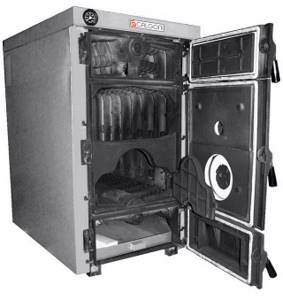
The disadvantages of cast iron products are:
- the large mass of the boiler requires a separate foundation;
- difficulties in the assembly process and high transportation costs;
- sensitivity to thermal shock - cast iron does not like temperature changes, so contact of a hot surface with cold firewood or cold water can be detrimental to it;
- high thermal inertia - it takes a long time to warm up the boiler, but its subsequent cooling occurs slowly.
As for steel products, they are less sensitive to temperature changes and are not afraid of contact with cold objects. This property allows, when assembling solid fuel heating boilers according to drawings, to equip them with sensitive automatic elements. And thanks to their low inertia, such units quickly warm up and cool down - this allows you to regulate the air temperature in the house. At the same time, you can make a drawing of a long-burning solid fuel boiler with your own hands, which will allow you to take into account all the nuances.
In appearance, steel boilers are solid welded units that are quite difficult to transport, although their sensitivity to mechanical damage is much lower than their cast iron counterparts.
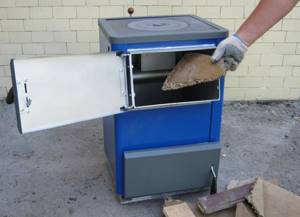
The possibility of repairing steel boilers is, from the point of view of some experts, very doubtful. Repairing, as well as welding a boiler with your own hands according to a drawing at home, is quite difficult; over time, leaks may form at the seams in it. In fairness, we note that everything depends on the worker’s skills in working with a welding machine. But repairing a cast iron heat exchanger is still easier - you only need to replace the sections.
As a rule, boilers with cast iron heat exchangers are non-volatile and inexpensive, so they can be a worthy alternative to already installed heating equipment in the event of a power outage. Coolant circulation in such units occurs naturally, without the use of a pump. However, the batteries must be installed in such a way that when heated, water moves freely through the pipes under the influence of pressure in the boiler.
Selecting a circulation pump for a heating system
In order to select a circulation pump for the heating system, it is necessary to make the appropriate calculations
Please note that within an hour, this element will drive three times more water than its total volume in the system. Thus, the total volume of a suitable amount of liquid is on average 10 liters per 1 kilowatt of heating boiler power
The required pump model for the heating system and its power are determined by pressure and flow parameters. The pressure must be equal to the hydraulic resistance of the heating system.
Typically, the fluid pressure velocity in systems with forced circulation is quite low, which gives the right to judge low losses of hydraulic resistance, which usually do not exceed 2 meters. It is quite difficult to calculate the exact resistance, so the performance of the circulation pump is determined by the midpoint. In order to calculate productivity, the size of the area of the heating object and the power of the electricity source are also taken into account. It should be remembered that a pump is only needed in a system with forced circulation; a system with natural circulation does not need it.
Calculate boiler power online
Many manufacturers, realizing that not everyone can do the calculations, have made sure that it is extremely easy to find out the required power. Websites contain special calculators where, by setting indicators, you can instantly get the calculation result.
You just need to know:
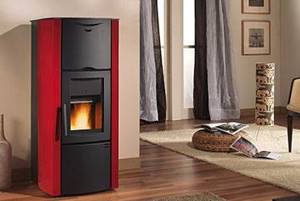
- desired temperature for the room;
- average t in the coldest week of the year;
- will the boiler heat drinking water;
- is there a ventilation system;
- ceiling height;
- number of storeys;
- thickness of external walls;
- material of walls and ceilings;
- length of each wall;
- number and sizes of windows;
- window type.
So. Correctly calculating the boiler power is one of the most important tasks in organizing heating. And doing it yourself is quite possible. Online calculators can also help.

